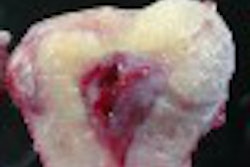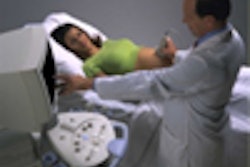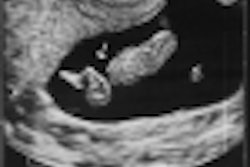Uterine fibroids are linked to an increased risk of spontaneous pregnancy loss, according to a Harvard University School of Medicine study that tracked the pregnancies of women with fibroids that were sonographically detected during the first trimester.
The study, which compared 143 women with fibroids to a control group of 715 women with normal uteruses, found that women in the former group suffer almost twice as many pregnancy losses (14.0% versus 7.6%). In addition, the pregnancy loss rate is higher in women with multiple fibroids compared to women with only one fibroid (23.6% versus 8%).
"In terms of patient management, I would counsel a woman with multiple uterine fibroids who was trying to get pregnant that there is about a 25% chance that even if she does succeed in getting pregnant, she may lose it," said Dr. Carol Benson, associate professor of radiology at Harvard and co-director of high-risk obstetrical ultrasound at Brigham and Women’s Hospital, both in Boston. "I may suggest she have the fibroids removed before she gets pregnant."
Uterine fibroids are benign nodules of muscle cells and fibrous connective tissue within the wall of the uterus. According to the National Institute of Child Health and Human Development, conservative estimates indicate that between 20% and 30% of women of reproductive age have fibroids, while other studies indicate fibroids are much more prevalent. Although most fibroids do not pose a threat, in some cases the pathology causes severe pain and excessive bleeding. Infertility, spontaneous abortion, and the early onset of labor have also been linked to fibroids.
Benson’s study picks up on a previous study she conducted that determined that women with uterine fibroids suffer twice the number of pregnancy losses compared to healthy women. In her more recent study, published in the Journal of Clinical Ultrasound, she further refined her inquiry by examining whether the number, size, and location of fibroids has an impact on pregnancy outcomes. And although she found that multiple fibroids are linked to a greater risk of pregnancy loss, fibroid size and location are not associated with complications, she said (June 2001, Vol. 29:5, pp.261-4.)
The study also found that women with fibroids were more likely to have cesarean-section deliveries. Benson's study didn’t examine why, but she believes that because fibroids distort the uterine cavity, cesarean section is necessary in many cases to ensure a safe birth. In addition, fibroids tend to be especially painful during pregnancy, so the pregnancy is often electively expedited via cesarean section.
Finally, the study found that among patients with fibroids, 14.7% of pregnancies required assisted conception, compared to only 6.4% of pregnancies among the control group.
Another recent study examined whether embolization, an increasingly common method of treating uterine fibroids, affects a woman’s ability to bring a pregnancy to term. In the procedure, a catheter is threaded into the uterine artery, and a gel is injected that blocks blood flow to the fibroid, causing it to shrink.
The UCLA study found that out of 139 women who underwent the procedure and who expressed a desire for fertility afterward, there were 17 pregnancies in 14 women, and five spontaneous abortions. At the time the study was published, 10 women had experienced normal-term deliveries.
These numbers are roughly equivalent to fertility rates observed after myomectomy, which is a more invasive, surgical removal of fibroids. Because of this favorable comparison, the authors concluded that a desire for future pregnancy shouldn’t interfere with a decision to undergo fibroid embolization (International Journal of Gynecology and Obstetrics, July 2001, Vol. 74:1, pp.1-7).
By Dan KrotzAuntMinnie.com contributing writer
November 14, 2001
Related Reading
Uterine fibroid embolization can be done without ob/gyn support, March 8, 2001
Demand surges for uterine fibroid embolization, March 5, 2001
Adenomyosis: sonographic findings and diagnostic accuracy, October 17, 2000
Empty bladder may be rule, not exception for pelvic ultrasound, April 24, 2000
Copyright © 2001 AuntMinnie.com



















